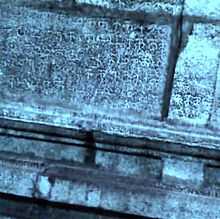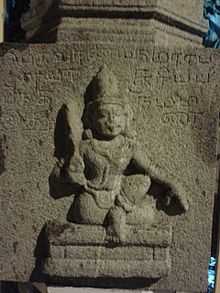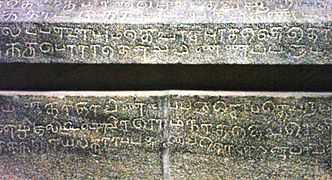Tamil Inscriptions of Bangalore
There are 1000s of inscriptions in Tamil in the Southern Karnataka districts of Bangalore, Mysore, Kolar and Mandya. Nearly one third of these inscriptions are found in the Kolar District. Only about 25% of the total Tamil inscriptions found in the Kolar District have been recorded in the Epigraphia Carnatica Volume X. The Tamil inscriptions start to appear around 1000AD, after the conquest of the region by the great Chola king Rajaraja Cholan. Even after the Cholas left, the Hoysala and late the Vijaynagar kingdoms continued to use Tamil in the inscriptions.[1]
Tamil inscriptions are found south of the Pennar-Ponnaiyar divide, running south west from Bangalore to Mysore. Several Tamil inscriptions are found in the Honnu-Hole basin.[2]
Temple Inscriptions
Chokkanathaswamy Temple, Domlur
The Chokkanathaswamy Temple is a 10th-century Chola temple, located in Domlur. There are a number of Tamil inscriptions in the temple. Domlur is called as Tombalur or Desimanikkapattanam in these inscriptions. Chakravarthi Posalaviraramanatha Deva has left inscriptions with directions to temple authorities of his kingdom. Further some inscriptions record the tributes, taxes and tolls made to the temple by Devaraya II of Vijayanagar Empire, which state the houses, wells, land around Tombalur were offered to the deity Sokkapperumal. Another Tamil inscription dated 1270 talks about 2 door posts being donated by Alagiyar. Yet another inscription in Tamil details Talaikkattu and his wife donating lands from Jalapalli village and Vinnamangalam tank to the deity. A 1290AD inscription talks about donation of ten pens from the revenue of Tommalur by Poysala vira Ramananda.[3][4][5][6][7][8][9]
Someshwara Temple, Madivala
The Someshware temple at Madivala is one of Bangalore's oldest, dating back to the Chola period. There are a number of Tamil and Grantha inscriptions on the outer walls of the temple. The oldest of these inscriptions dates to 1247 AD talks about a land grants “below the big tank of Vengalur” by a Veppur (modern Begur) resident. Other inscriptions also talk about other land grants including those done during the reigns of Ballala III and Rajendra Chola. Another instrciption dated 1365 talks about land grand at Tamaraikkirai (which translates to 'lotus pond bank' in Tamil, and according to HS Gopala Rao, Secretary of the Karnataka Itihasa Academy refers to the present day Tavarekere suburb.[10][11]
-

Tamil Inscriptions at the Someshwara Temple, Madivala
-

Tamil Inscriptions at the Chokkanathaswamy Temple, Domlur
-

Tamil Inscriptions at the Chokkanathaswamy Temple, Domlur
Village Inscriptions
Kaadugodi
A Tamil inscription from dating 1043AD exists in Kadugodi, from the period of Rajendra Chola I, which describes the construction of the Pattanduru Lake, and Ganesh, Durga and Kshetrapaala temples by Chola chieftain Raja Raja Velan son of Permadi Gavunda.[12]
Marathahalli
Doddanekkundi village, located North of Marathahalli, and much older than Marathahalli, has two ancient inscriptions in Tamil. The first inscription dated 1304, mentions the village name as Nerkundi and talks about the existence of a fort around the village constructed in 1304. The second inscription talks about the Hoysala king Ballala III granting the entire revenue of the Doddanekkundi village to the Shivagange Temple. There is also a Telugu inscription in Marathahalli. According to scholars, this shows the use of Tamil and Telugu in Bangalore, much before the reign of Krishnadevaraya of the Vijaynagar Kingdom.[13]
British Period Inscriptions in Tamil
Madras Sappers War Memorial, Brigade Road
A war memorial raised by the British to commemorate the lives lost in different wars by the Madras Sappers Regiment. It details the number of British officers, Indian officers and soldiers who died fighting during Second Opium War in China, Third Anglo-Burmese War(1885–87), World War I, Mesopotamia (modern Iraq) (1916–18), East Africa (1914-18) and the North West Frontier (1915). The soldiers fell during the Indian wars of Assaye, Seringapatam, Seetabuldee and Sholinghur are also acknowledged. The inscriptions are both in English and Tamil.[14][15]
Broadway, Shivajinagar
When a encroached storm water drain was cleared in Shivajinagar, a huge plaque dating back to the 19th century was found. The stone, shows the progress of the building of the British Bangalore Cantonment. It reads 'This stone laid across the main channel in 1868 and worn by the feet of two generations was set up to mark the opening of this bridge and road on 16 February 1922'. The inscription is in English, Tamil and Urdu. According to SK Aruni, deputy director of the Indian Council of Historical Research, Tamil was used as all the workers of the British were Tamil people, and Urdu to communicate to the Hindustani men working for the British.[16]
-
British War Memorial in Bangalore in English & Tamil
-

Madras Regiment War Memorial, Bangalore
References
- ↑ Subbarayalu, Y (1990). Sreenivasa, H V; Rao, B Surendra; Veluthat, Kesavan et al., eds. Essays on Indian History and Culture: Felicitation Volume in Honour of Professor B. Sheik Ali (First ed.). New Delhi: Mittal Publications. p. 101. ISBN 8170992117. Retrieved 17 January 2015.
- ↑ Iyer, (Diwan Bahadur) L Krishna Anantha Krishna (1936). The Mysore Tribes and Castes. Madras, British India: Mittal Publications. p. 104. Retrieved 17 January 2015.
- ↑ Rice, Benjamin Lewis (1887). Mysore: A Gazetteer Compiled for Government. London, UK: Asian Educational Services. p. 70. ISBN 8120609778. Retrieved 17 January 2015.
- ↑ Githa, U B (19 April 2004). "A Chola temple in Domlur!" (Bangalore). Deccan Herald. Retrieved 4 January 2015.
- ↑ Githa, U B. "Chokkanathaswamy Temple, a fine example of Chola architecture". Chitralakshana: All about Indian Art. Retrieved 17 January 2015.
- ↑ Sridhar, Lakshminarasimhan; Sridhar, Geetha. "Chokkanarayan Swamy Temple Domlur". Vishnu Temples of Karnataka. Retrieved 16 January 2015.
- ↑ Rao, Priyanka S (19 May 2012). "Chokkanatha: The city’s oldest temple" (Bangalore). The New Indian Express. Retrieved 18 January 2015.
- ↑ Harshitha, Samyuktha (10 December 2012). "The temple of the Cholas". Suttha Muttha. Retrieved 25 January 2015.
- ↑ Rizvi, Aliyeh (20 October 2014). "Good vibrations" (Bangalore). Bangalore Mirror. Bangalore Mirror Bureau. Retrieved 6 February 2015.
- ↑ Iyer, Meera (20 July 2009). "Ancient temple; bustling junction" (Bangalore). Deccan Herald. Retrieved 4 January 2015.
- ↑ Srikumar, S (12 March 2014). Kolar Gold Field: (Unfolding the Untold) (International ed.). Partridge Publishing. p. 57. ISBN 1482815079. Retrieved 18 January 2015.
- ↑ Krishnamurthy, P V (2005). "Inscriptions of Bangalore East Taluk - A Study". Itihasa Dharshana 20. Retrieved 16 January 2015.
- ↑ Aruni, S K (12 January 2012). "Of inscriptions and the medieval period" (Bangalore). The Hindu. Retrieved 16 January 2015.
- ↑ Rodricks, Allan Moses (19 September 2014). "A chapter from the war" (Bangalore). The Hindu. Retrieved 5 January 2015.
- ↑ Karthik, S A (11 August 2014). "A memorial for WWI Warriors" (Bangalore). Deccan Herald. Retrieved 16 January 2015.
- ↑ "Slice of history found in encroached drain" (Bangalore). Times of India. 15 January 2015. Retrieved 16 January 2015.